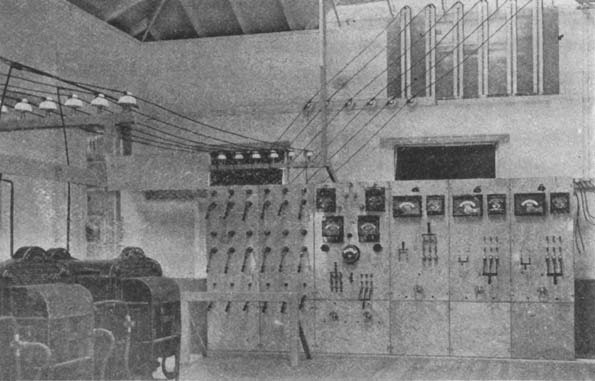[Trade Journal]
Publication: American Electrician
New York, NY, United States
vol. 8, no. 3, p. 107-108, col. 1-3,1-2
A THIRTY-FIVE MILE ELECTRICAL
POWER TRANSMISSION PLANT.
One of the most interesting electrical transmission plants in the United States has recently been completed at Fresno, Cal. The generators are run by Pelton wheels supplied with water under the enormous head of 1600 ft., the water being led to the power house by a steel pipe line 4100 ft. long, and 22 ins. in diameter at the lower end.
The water wheels are of the impulse type, each capable of developing 500 HP at 600 r. p. m. under a working head of 1400 ft., corresponding to a pressure of 610 lbs. per square inch; Separate wheels are provided for the exciters.
| |||
| Power House — Fresno Plant. |
The electric plant consists of three General Electric three-phased generators, each of 350 KW capacity at a speed of 600 revolutions. The armatures are directly connected to the water wheels by insulated flange couplings. The exciters used are of the slow speed multipolar type. The current from the generators is delivered to six 125-KW step-up transformers of the air blast type, with secondaries wound for 11,200 volts, to which pressure the current for the transmission line is raised. From the transformers, the current passes to a polished marble switchboard, consisting of six panels, three of which are generator panels, one an exciter panel and the other two for operating the combination of the six transformers.
The 11,200-volt circuit, consisting of six bare copper wires, crosses the San Joaquin River with a span of 275 ft. wide, and is then led up the mountain for a distance of about 2000 ft. The line continues for about ten miles through a rolling, hilly country, is easy of access and at all times below the snow line; the rest of the distance the line runs over a flat country, and near Fresno passes through wheat fields and vineyards and follows a special right-of-way and wagon road for the entire distance. The total length of the transmission line from the power house to the sub-station is little short of 35 miles, and is thus the longest commercial electric power transmission in the world. The line is strung on special high tension porcelain insulators, which were tested under 27,000 volts alternating before use. The poles are of square redwood, 35 ft. long, set 6 ft. into the ground and fitted with three, heavy cross arms and one small cross arm for telephone wires.
| |||
| Generator Room — Fresno Plant. |
The sub-station at Fresno is almost in the center of the business portion of the city, and is a brick structure 55 ft. X 45 ft. The high pressure circuits entering the house are brought to nine step-down transformers, also of the air blast type. Three of these are of 125-KW capacity, and reduce the pressure to 200 volts; three of 75-KW capacity with secondaries of a 1000 volts; and three are of 40-KW capacity, reducing the pressure to 3000 volts. In addition to these transformers, the station also contains two 80-light Brush arc machines directly driven by two 60-HP, three-phased induction motors.
| |||
| Switchboard — Fresno Plant. |
The system of distribution from the substation is divided up into three networks. The first is a 200-volt, four-wire, low-tension network, which covers the business portion of tile town, and has an initial capacity of 6000 16-CP incandescent lamps. The second is a 1000-volt, three-phased system covering the residence districts of the town, and having an initial capacity of 4000 16-CP incandescent lamps. The third is a 3000-volt, three-phased circuit designed to furnish current to the numerous vineyards and wineries within a radius of ten miles from the sub-station, for both lighting and power purposes. Motors will also be furnished with current from both the 200-volt and 1000-volt circuits.



